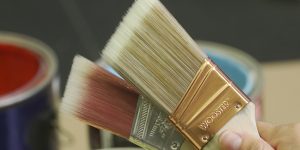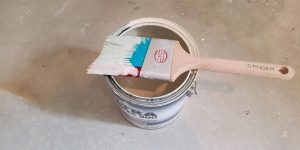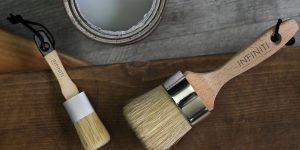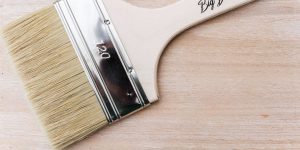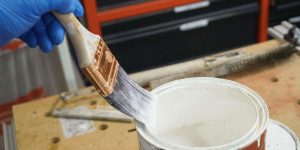Oil-based paints are thick. So you can’t grab a random paintbrush and start adding bright colors to your DIY project or refreshing the furniture. At least if you do not want your project to flop.
So today, I will share some tips with you on how to pick between the best paint brushes for oil-based paint and choose the one that would be a perfect match for your needs. If you are too overwhelmed with the brush options the market offers, that’s not a big deal. I’ve tested and reviewed the products that would perfectly do for oil-based paints so that you don’t have to figure it out the hard way.

Brushes for oil-based paint comparison table
| Name | Size | Material | Brush shape | Review |
|---|---|---|---|---|
| Purdy XL Glide best overall | 3 inch /76 mm | Nylon/polyester | Angled | Review |
| Purdy Ox-O-Angular small | 1.5 inch/38 mm | Natural | Angled | Review |
| Wooster Softip Q3108 budget | 2 inch/50 mm | Nylon/polyester | Straight | Review |
| Perdura Rapid Stain large | 5 inch/127 mm | PET filaments | Wide | Review |
Why do I need a special brush for oil-based paint?

When it comes to working with paint on wood, using the right equipment is crucial. Here’s why you need a specifically designed paint brush for oil-based stain:
- Chemical resistance: Oil paints contain solvents and chemicals that can be harsh on brushes. A brush made for oil paints is more resistant to these chemicals, preventing premature wear and tear.
- Bristle material: Brushes tailored for oil-based paints often feature natural bristles (like hog hair) or a synthetic blend optimized for oil-based products. These materials hold and distribute paint more effectively, resulting in a smoother finish.
- Minimize brush marks: A good brush for oil-based paint helps reduce visible brush marks on your final finish. These brushes are designed to minimize brushstrokes, giving your wood projects a professional, polished look.
How I tested paint brushes for oil-based paint
Every paintbrush from my review was involved in my home-renovation project. I painted the bedroom door with six brushes, carefully dividing the whole area into equal sections to better understand how they would do their job. You’ll learn what I figured out in a second.
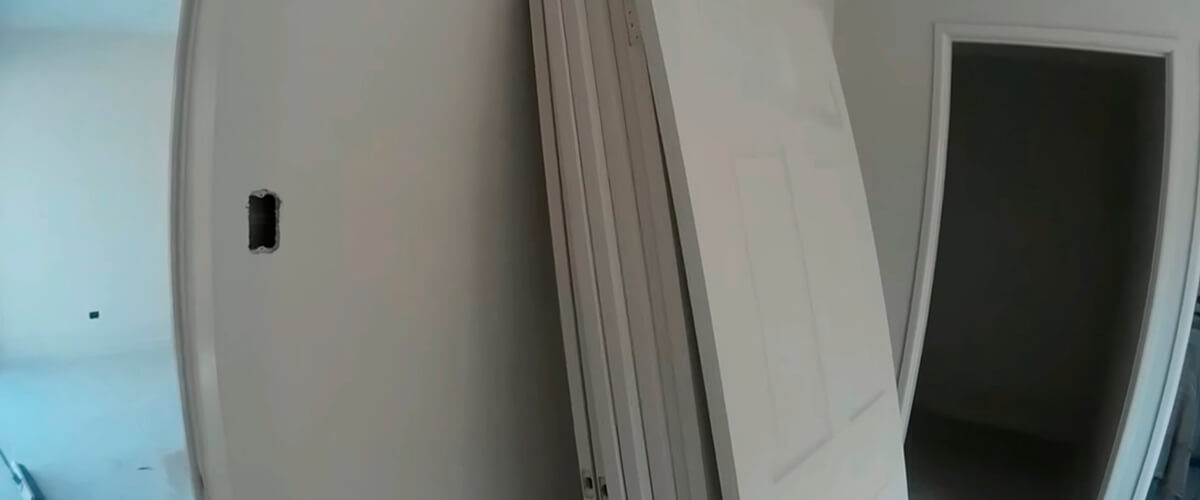
Best brushes for oil-based paint reviews
Purdy XL Glide – best overall

My journey with the Purdy XL Glide brush as the best brush for oil-based paint on wood has been nothing short of impressive! This 2.5-inch brush with tapered polyester bristles is suitable for all paint types, so it will also perfectly do for oil-based paints.
The natural hardwood handle feels comfortable in my hand, providing a good grip. However, I did notice that the brads holding the metal ferrule can become a bit flimsy with moderate use. It’s something to be mindful of, especially if you plan on using this brush extensively.

Unlike the soft Purdy White Bristle Sprig brush, this one is stiffer, so you will get better precision. The XL Glide brush delivers a smooth surface with no bristles ruining your work.
Being the best paint brush for oil-based paint, the Purdy XL Glide will help you complete the painting project easier and faster while gladdening you with a smooth result.
Key specs
- Size, inch/mm: 3/76.
- Material: Nylon/polyester.
- Brush shape: Angled.
Pros
- Tapered polyester bristles are moderately stiff for better precision.
- No shedding and smooth strokes.
- Angled bristle design is great for large areas and trimming.
- Ergonomic hardwood handle.
Cons
- The brads holding the ferrule wear out overuse.
Purdy Ox-O-Angular – small

The Purdy Ox-O-Angular trim brush with a flat rattail handle is the softest brush in my review, suitable for oil-based paints, stains, and clears.
What stood out to me was the brush’s unique blend of ox hair and white China bristles. While there was some initial shedding, it didn’t affect the quality of my work. I was pleasantly surprised to find no bubbles or missed spots while using this brush, which is crucial for achieving a flawless finish.

Furthermore, the angled design makes it a great choice for edging and trimming. Because of the 2-inch width, this brush will do for small projects as well. The handle is lightweight, and it doesn’t feel heavy in your hand.
The Purdy 1.5 inch oil paint brush will become your reliable helper for delicate surfaces or small painting projects.
Key specs
- Size, inch/mm: 1.5/38.
- Material: Natural.
- Brush shape: Angled.
Pros
- The blend of ox hair and white China bristles for a smoother coverage.
- 2-inches wide for painting small objects.
- Angled bristle shape is great for edging and trimming.
Cons
- Bristled shed heavily.
Wooster Softip Q3108 – budget
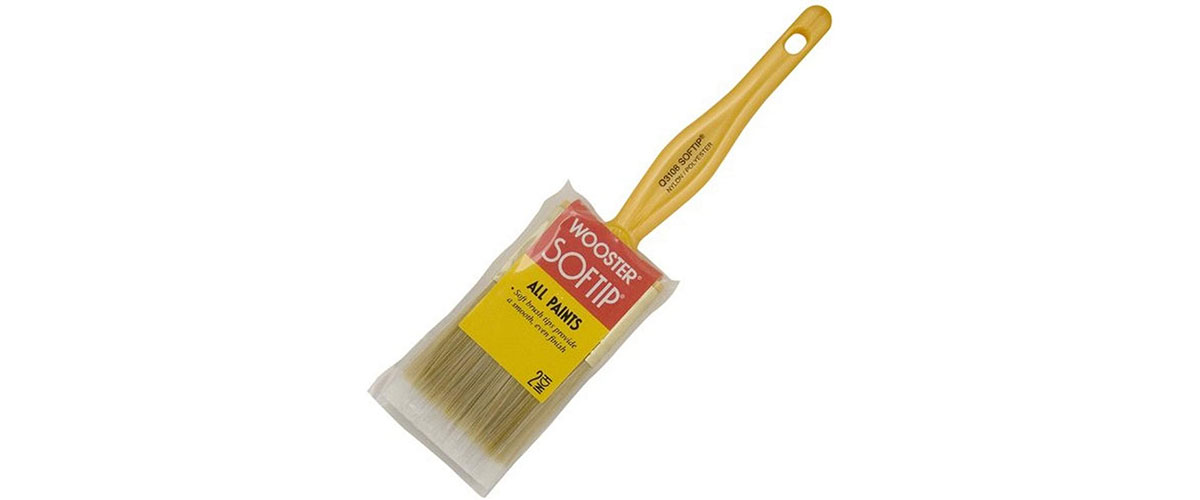
A Wooster Softip 2-inch soft flat brush features a synthetic bristles blend for latex and oil-based paints.
In contrast to the stiff Purdy XL Glide brush, this one is softer and does not lose many bristles. But it doesn’t result in smoother strokes because the upper part of the brush absorbs paint, while the ends do not. As a result, the paint comes off, making messy streaks.

The handle is made of plastic, so it is slightly sleek and not as durable as wood.
The Wooster Softip is the best brush for oil-based paint if you do not want to invest much in the painting tool, and the smooth finish is not that critical for you.
Key specs
- Size, inch/mm: 2/50.
- Material: Nylon/polyester.
- Brush shape: Straight.
Pros
- Soft flat brush suitable for latex and oil-based paint.
- The 3-inch wide brush is great for large projects.
- Synthetic bristles do not shed much.
Cons
- A plastic handle is sleep and easy to break.
- Strokes are not smooth.
- Messy when making strokes.
Perdura Rapid Stain – large
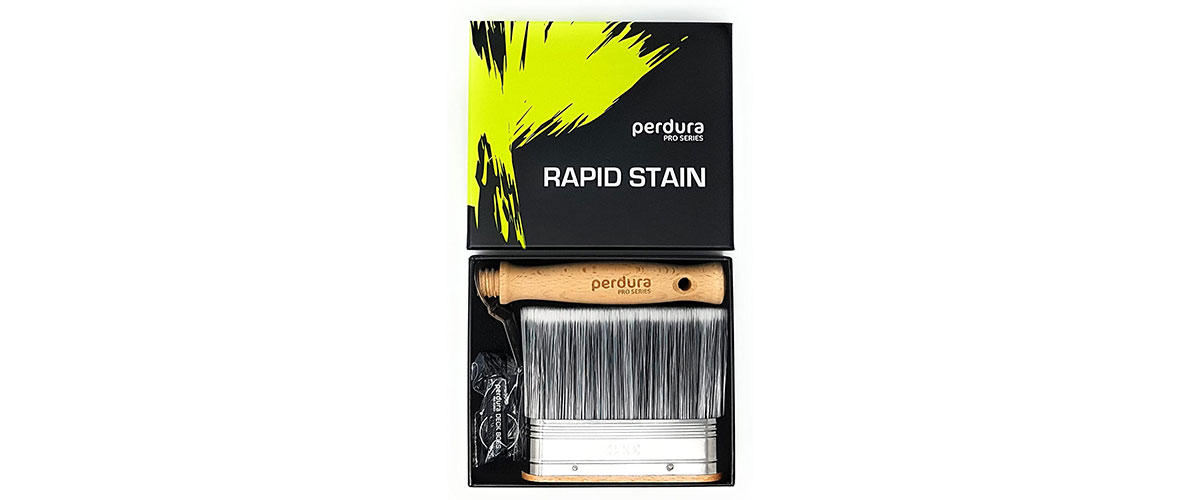
The Perdura Rapid Stain flat brush is a good choice for coating decks, fences, railing on rough or smooth surfaces.
One thing I noticed is that the Perdura Rapid Stain brush, although it’s an inch smaller than the Wooster Bravo Stainer brush I’ve used before, is incredibly versatile. It easily handles water and oil-based paints, stains, sealers, epoxy, and varnish for both wood and concrete surfaces.
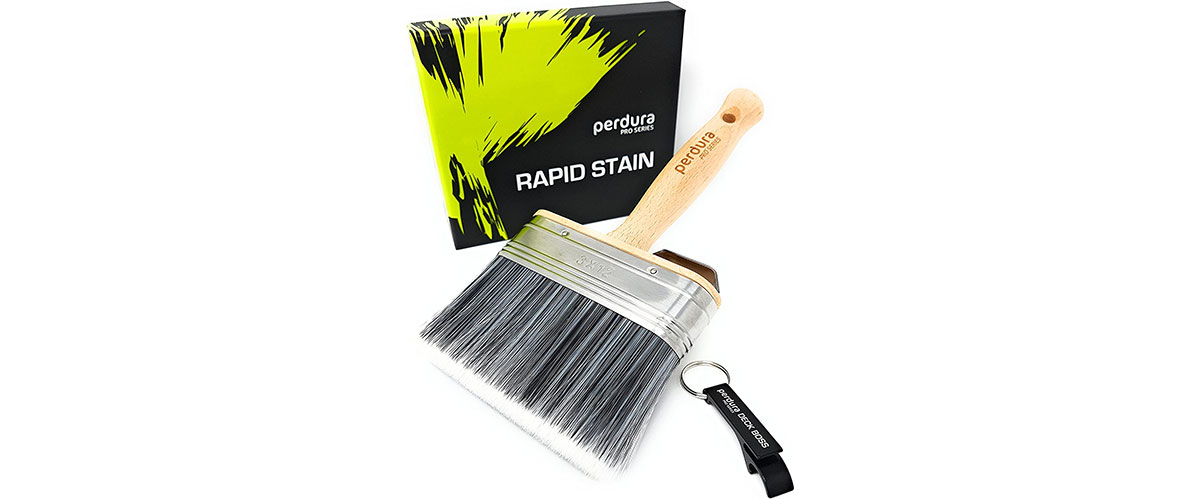
I have worked with it on different surfaces and with various types of paint, and the results have been quite good in all cases. I’ll make one interesting point. The tapered synthetic bristles start off tightly packed, ensuring even application, but I did find that they became a bit loose after a few hours of continuous work. Nevertheless, it didn’t significantly affect the overall performance.
No doubt, the Perdura Rapid Stain brush is not what you need for small projects. But it is a true beast for staining decks, flooring, and other large surfaces.
Key specs
- Size, inch/mm: 5/127.
- Material: PET filaments.
- Brush shape: Wide.
Pros
- 3-inch tapered synthetic bristles hold paint well.
- Specially designed for large areas.
- The ergonomic handle compensates for the size of the brush.
Cons
- Bristles get loose after a few hours of work.
- Might not work for small projects.
Purdy White Bristle

Purdy White Bristle is a professional oil paint brush with soft bristles suitable for oil-based paints, stains, and clears.

Just like the Purdy XL Glide brush, this item is also 3 inches wide. But the Purdy White Bristle brush has a flat bristle design, making it a great item for woodwork, furniture, and other surfaces. The Alderwood handle ensures balance and comfort.
The natural bristles are soft, so they provide a smooth finish. It does lose a few bristles, but not dramatically. Also, this brush might not hold oil paint in bristles without making a mess all around. So, the Purdy White Bristle brush can be a better choice for outdoor projects.
Key specs
- Size, inch/mm: 3/76.
- Material: Natural.
- Brush shape: Straight.
Pros
- An optimal brush width for almost any project – 2.5 inches.
- Soft natural bristles for woodwork and furniture.
- Flat bristle design for even strokes.
- Alderwood handle for a comfy grip.
Cons
- Noticed minimal shedding.
- Slightly messy and makes splashes.
Wooster Bravo Stainer

The Wooster Bravo Stainer square brush is designed for oil-based stains, sealers, and wood toners.
Similar to the Perdura Rapid Stain brush, this one is specially designed for large areas. It has a hardwood handle with a bucket clip to let you keep it on the paint bucket. But it’s one inch larger – 4 inches, so you will be covering more area in less time. The synthetic bristles are not messy, and they do not shed.

But since the edges are not tapered, the brush doesn’t apply paint easily. This brush also leaves some gaps, which are around ¼ inches. The hardwood handle is removable, so you can use a mop extension if needed.
This is a high-quality paint brush that would be especially handy for painting large areas.
Key specs
- Size, inch/mm: 4/101.6.
- Material: Polyester.
- Brush shape: Straight.
Pros
- 4 inches wide and thick – great for large projects.
- A detachable handle for easier cleaning and adding an extension.
- The synthetic bristles are not messy and do not shed.
Cons
- Might be hard to apply paint.
- Leaves some gaps.
Brush for oil-based paint buying guide
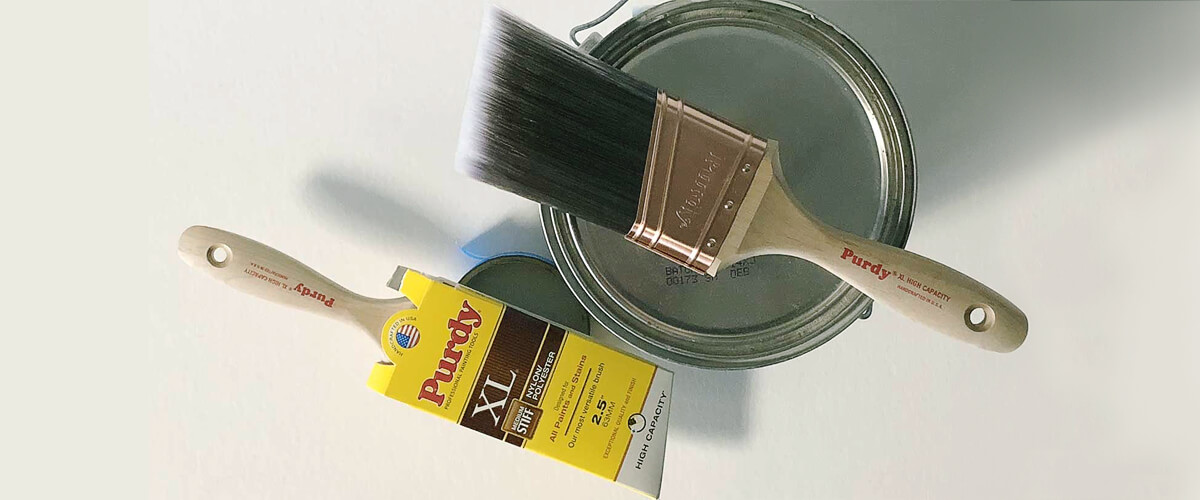
Natural vs synthetic paint brushes
Both natural and synthetic paintbrushes may do for oil-based paint. But the final choice will depend on the kind of project. Natural brushes are made of animal hair (usually hog due to the hair stiffness). They are a great choice for furniture or flat surfaces that do not require much painting precision. These brushes tend to shed, but if you buy a high-quality brush, this won’t be a problem.
Synthetic brushes for oil-based paint are made of nylon, polyester, or blend. These tools ensure smoother and more precise strokes, so they may do better for projects with intricate details. However, I am afraid they might not bring good results with oil paint.
What shape of the brush to choose?
Many oil-based paint brushes have a square-cut design. They are flat, and due to this shape peculiarity, hold and lay out paint on almost any surface but will do better for large flat areas. These brushes will help you make long, crisp lines. However, you may feel a lack of control, especially when painting corners, adjacent surfaces, or narrow edges.
You can also find sash paintbrushes. They are noted for long slim bristles, perfect for reaching into awkward areas, edging, or painting fancy objects.
There are also angled paintbrushes, which have their bristles cut at a slight angle. This bristle shape allows easier edging and trimming. You will also like these brushes for painting wide, flat surfaces.
What size of brush do I need?
Choose the brush size based on your project. Smaller brushes (1 – ½ inch-wide) are great for paintworks that require precision. They will also do woodwork jobs. You may want to get a wider brush (more than 2 inches) for painting 3-inch trim or other projects. In fact, this is an optimal size for most DIY painting projects. A larger brush (3 – 4 inches) would be a wise choice for dyeing wide, flat surfaces.
How to thin oil-based paint?
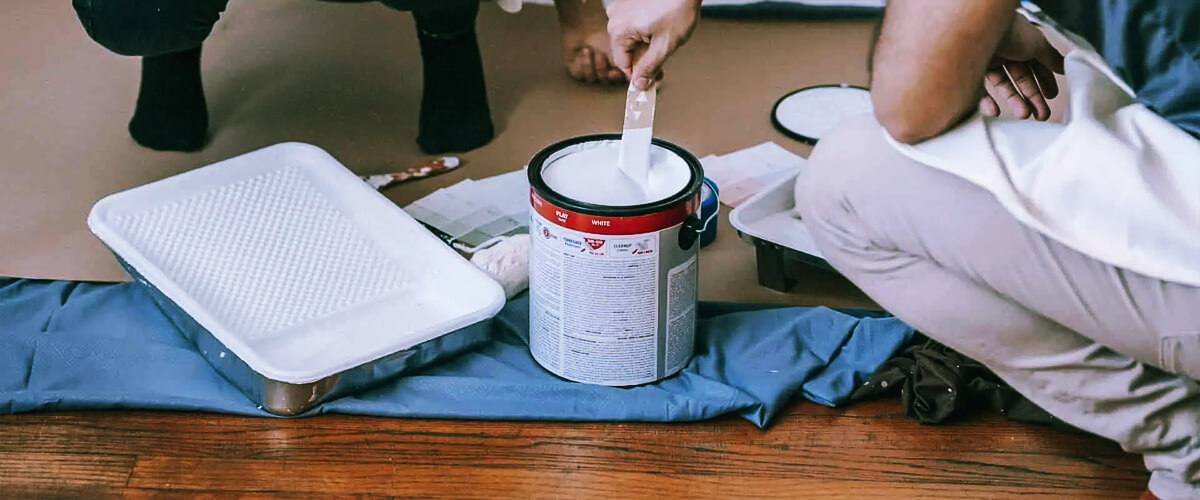
Thick oil paint may completely ruin your paintwork – it might get ridges, lumpiness, or peel off. So, to thin oil-based paint, prepare a pair of gloves to keep your hands clean and a container to mix paint with turpentine or mineral spirits. Here is a quick guide on how to get the job done, but you can learn more handy tips by jumping into this article.
- Pour paint into the container and remove any chunks of dried paint.
- Add turpentine or mineral spirits (the proportion is one part of turpentine or spirits to three parts of oil paint).
- Carefully stir it with a clean stick.
- Apply the paint onto the test surface to see the results.


